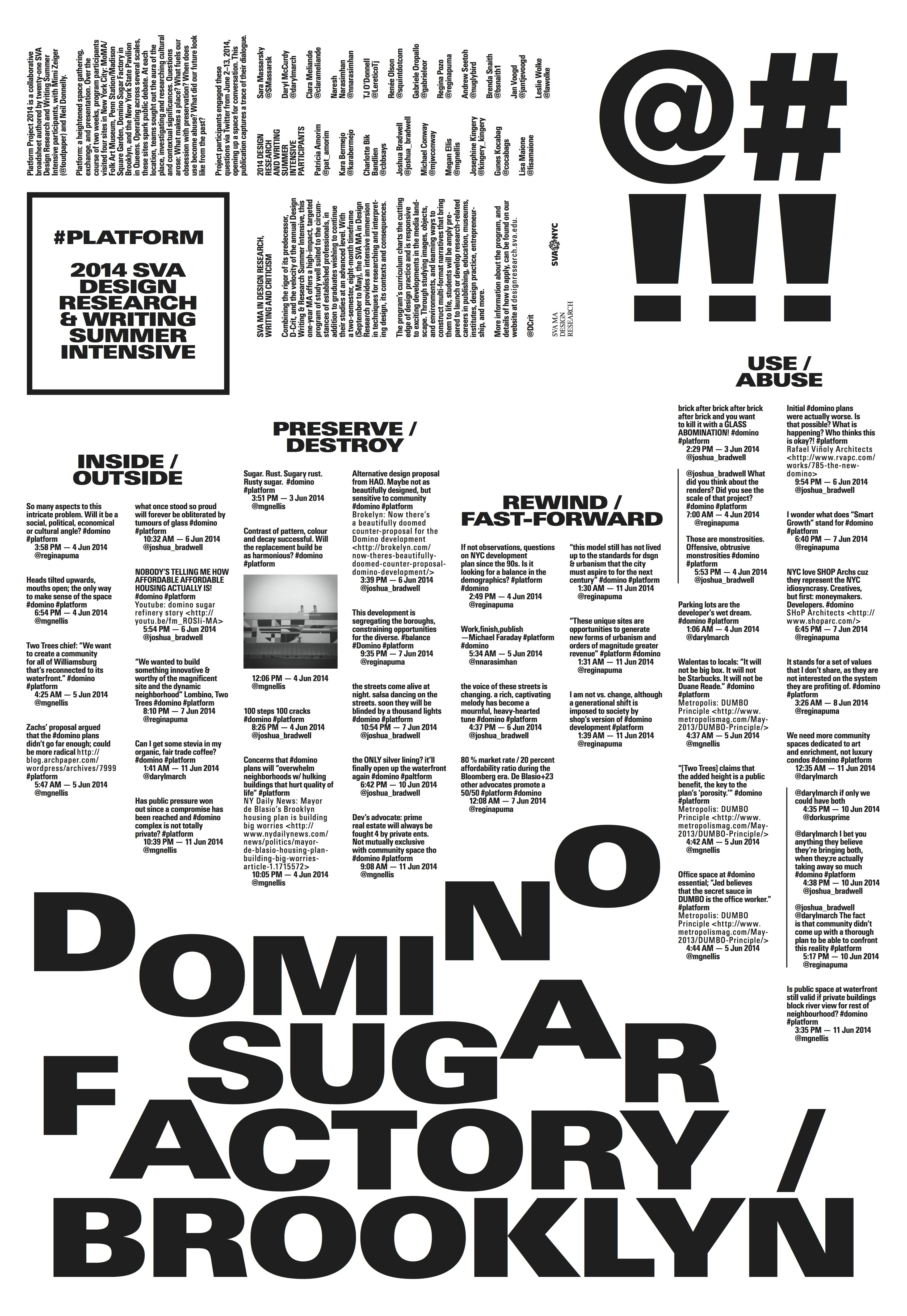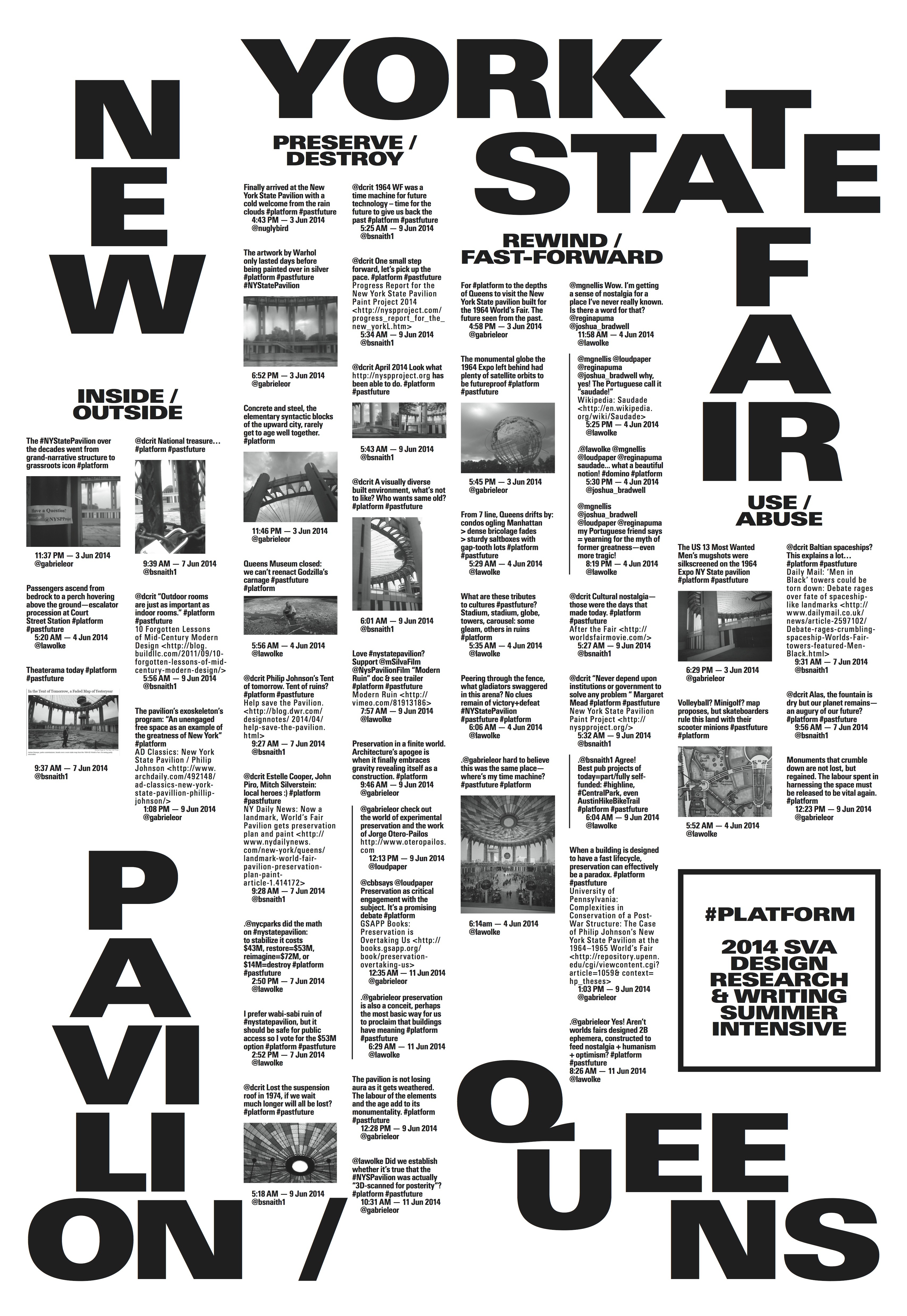Artigo para a revista Disegno (nº19)
2018
Fui convidada pela Disegno para escrever um artigo em forma de travelogue sobre a comunidade de design em São Paulo (pags 97-112). Interessado em ler? Entre em https://www.disegnodaily.com/journal
O número 19 da Disegno oferece um jornalismo aprofundado e de longa duração, além de retratos, fotografia artística e reportagem inspiradoras, que fornecem uma janela para o design contemporâneo e áreas afins.
2018
Fui convidada pela Disegno para escrever um artigo em forma de travelogue sobre a comunidade de design em São Paulo (pags 97-112). Interessado em ler? Entre em https://www.disegnodaily.com/journal
O número 19 da Disegno oferece um jornalismo aprofundado e de longa duração, além de retratos, fotografia artística e reportagem inspiradoras, que fornecem uma janela para o design contemporâneo e áreas afins.
Disegno Magazine (nº19)
2018
I was invited by Disegno to write a Travelogue about São Paulo’s design comunity (pp 97-112). If you wanna read it, please go to https://www.disegnodaily.com/journal
Disegno #19 offers in-depth, long-form journalism and critical writing, as well as inspiring portraiture, arts photography and reportage, all of which provide a window onto contemporary design and surrounding fields.
2018
I was invited by Disegno to write a Travelogue about São Paulo’s design comunity (pp 97-112). If you wanna read it, please go to https://www.disegnodaily.com/journal
Disegno #19 offers in-depth, long-form journalism and critical writing, as well as inspiring portraiture, arts photography and reportage, all of which provide a window onto contemporary design and surrounding fields.


Editora temporária, segunda edição, 2017. Premiado com o Rumos Itau Cultural.
Editora temporária é um projeto de ocupação que propõe o encontro entre pessoas interessadas em pensar publicações de pequenas tiragens com temas relacionados à cidade e sua vivência. Através de uma chamada pública selecionamos projetos para serem desenvolvidos e transformados em livros em aproximadamente três meses. O tema da segunda edição foi a mudança urbana pela qual o Rio de Janeiro passou recentemente devido aos grandes eventos que abrigou.
Os designers Ana Costa, Tatiana Podlubny e Thiago Lacaz participaram conosco da difícil tarefa de escolher 3 dentre 117 pesquisas de pessoas entre 12 e 70 anos, vindas de diversos cantos do país.
O livro “De quem te protege a muralha?”, do historiador e escritor Thiago Florencio, é uma proposta de deriva pela região central do Rio de Janeiro. Ele fala sobre uma grande muralha, que mesmo de curta sobrevivência, e cuja construção não tenha sido totalmente concluída, existiu na cidade do Rio de Janeiro. Em seu projeto original de 1714 ela deveria atravessar a cidade desde o pé do Morro do Castelo, margeando a atual Rua Uruguaiana, passar por cima do Morro da Conceição até findar no Largo da Prainha, nos arredores da atual Praça Mauá. Por meio de uma caminhada, marcada por encontros e descobertas, refizemos o trajeto da muralha, entendendo o que era o dentro e o fora da cidade, o que era margem e o que era centro. A encadernação do livro reforça a ideia de 2 lados, dentro e fora, estabelecido e marginalizado, por ter páginas costuradas dobradas, que só são visíveis se o leitor as abrir lateralmente.
“Zonzo: investigadores urbanos” nasceu a partir de um convite a 28 crianças de 09 a 13 anos residentes na Favela da Babilônia, para narrar, mapear e reconstruir coletivamente o espaço onde moram. Juntas com a arquiteta Julia Sant’Anna e a estudante de direito Carolina Movilla, as crianças brincaram, observaram, identificaram, desenharam e reconheceram seu território, seus deveres e direitos, e tornaram-se investigadoras urbanas. O livro convida outras crianças, através dos registros desses meninos e meninas, a zanzarem pela cidade como exercício para entender de onde vêm, quais são suas referências, conhecer seu entorno, sonhar e reivindicar o lugar onde querem viver. O livro é recheado de propostas de investigação e descobrimento partindo da casa, da rua, do bairro até a cidade. Uma publicação sobre mapeamento e urbanismo de crianças para crianças.
“Mobilidade Performativa”, de Elilson Nascimento, propõe através da realização de performances em ruas e em transportes coletivos, colocar em trânsito as transformações na cidade do Rio de Janeiro. O trabalho expõe relações teóricas entre mobilidade urbana e arte da performance, enquanto narra transformações pontuais ocasionadas pelo próprio ato performático no cotidiano da cidade.
Fizemos uma exposição com o processo de desenvolvimento dos 3 livros no Centro Carioca de Design. Fizemos linhas do tempo com os rastros, vestígios, experimentos e testes das publicações.
Editora temporária é um projeto de ocupação que propõe o encontro entre pessoas interessadas em pensar publicações de pequenas tiragens com temas relacionados à cidade e sua vivência. Através de uma chamada pública selecionamos projetos para serem desenvolvidos e transformados em livros em aproximadamente três meses. O tema da segunda edição foi a mudança urbana pela qual o Rio de Janeiro passou recentemente devido aos grandes eventos que abrigou.
Os designers Ana Costa, Tatiana Podlubny e Thiago Lacaz participaram conosco da difícil tarefa de escolher 3 dentre 117 pesquisas de pessoas entre 12 e 70 anos, vindas de diversos cantos do país.
O livro “De quem te protege a muralha?”, do historiador e escritor Thiago Florencio, é uma proposta de deriva pela região central do Rio de Janeiro. Ele fala sobre uma grande muralha, que mesmo de curta sobrevivência, e cuja construção não tenha sido totalmente concluída, existiu na cidade do Rio de Janeiro. Em seu projeto original de 1714 ela deveria atravessar a cidade desde o pé do Morro do Castelo, margeando a atual Rua Uruguaiana, passar por cima do Morro da Conceição até findar no Largo da Prainha, nos arredores da atual Praça Mauá. Por meio de uma caminhada, marcada por encontros e descobertas, refizemos o trajeto da muralha, entendendo o que era o dentro e o fora da cidade, o que era margem e o que era centro. A encadernação do livro reforça a ideia de 2 lados, dentro e fora, estabelecido e marginalizado, por ter páginas costuradas dobradas, que só são visíveis se o leitor as abrir lateralmente.
“Zonzo: investigadores urbanos” nasceu a partir de um convite a 28 crianças de 09 a 13 anos residentes na Favela da Babilônia, para narrar, mapear e reconstruir coletivamente o espaço onde moram. Juntas com a arquiteta Julia Sant’Anna e a estudante de direito Carolina Movilla, as crianças brincaram, observaram, identificaram, desenharam e reconheceram seu território, seus deveres e direitos, e tornaram-se investigadoras urbanas. O livro convida outras crianças, através dos registros desses meninos e meninas, a zanzarem pela cidade como exercício para entender de onde vêm, quais são suas referências, conhecer seu entorno, sonhar e reivindicar o lugar onde querem viver. O livro é recheado de propostas de investigação e descobrimento partindo da casa, da rua, do bairro até a cidade. Uma publicação sobre mapeamento e urbanismo de crianças para crianças.
“Mobilidade Performativa”, de Elilson Nascimento, propõe através da realização de performances em ruas e em transportes coletivos, colocar em trânsito as transformações na cidade do Rio de Janeiro. O trabalho expõe relações teóricas entre mobilidade urbana e arte da performance, enquanto narra transformações pontuais ocasionadas pelo próprio ato performático no cotidiano da cidade.
Fizemos uma exposição com o processo de desenvolvimento dos 3 livros no Centro Carioca de Design. Fizemos linhas do tempo com os rastros, vestígios, experimentos e testes das publicações.
Temporary Publisher, Second Edition, 2017. The project was contemplated by the Rumos Itaú Cultural award.
Temporary Publisher is an occupation project that allows for the encounter between people interested in thinking short-run publications with themes related to the city and its experience. Through a public call, we selected some projects to be developed and transformed into books in approximately three months. The theme of this second edition was the urban transformation that Rio de Janeiro has recently gone through for the major events hosted by the city.
The designers Ana Costa, Tatiana Podlubny and Thiago Lacaz participated with us in the difficult task of selecting 3 of the of 117 research projects from people ranging from 12 to 70 years old, from various parts of the country.
The historian and writer Thiago Florencio's book "Who Protects You from the Wall?" is an invitation to drift through the central region of Rio de Janeiro. He tells us about a great wall that, albeit not having lasted long nor having been fully completed, existed in the city of Rio de Janeiro. In its original 1714 project, it was supposed to run across the city from the foot of Morro do Castelo, bordering the current Uruguaiana Street, going over Morro da Conceição until it reached Largo da Prainha, in the surroundings of the current Praça Mauá. Through a walk, marked by encounters and discoveries, we retraced the path of the wall, understanding what was inside and outside the city, what was marginal and what was central. The binding of the book reinforces the idea of two sides, in and out, established and marginalized, by having its sewn pages folded, only becoming visible if the reader opens them sideways.
"Zonzo: urban researchers" was born from an invitation to 28 children from 9 to 13 years old, living in Favela da Babilônia (Babilonia Slum), to collectively narrate, map and reconstruct the space where they live. Together with the architect Julia Sant'Anna and the Law student Carolina Movilla, the children played, observed, identified, designed and recognized their territory, their duties and rights, and became urban researchers. The book invites other children, through the records of these boys and girls, to wander around the city as an exercise to understand where they come from and what their references are, to get to know their surroundings, to dream and claim their right to the place where they want to live. The book is filled with research and discovery proposals starting from each house, street and neighborhood to the city. A publication on mapping and urbanism from children to children.
Elilson Nascimento's "Performative Mobility" proposes to set in transit the transformations in the city of Rio de Janeiro, through performances in the streets and in public transport. His work exposes theoretical relations between urban mobility and performance art, while narrating specific transformations caused by the performance act itself in the city's daily life.
We made an exhibition showcasing the development process of the 3 books at Centro Carioca de Design (Carioca Design Center), as well as timelines with its traces, vestiges, experiments and publications tests.
Temporary Publisher is an occupation project that allows for the encounter between people interested in thinking short-run publications with themes related to the city and its experience. Through a public call, we selected some projects to be developed and transformed into books in approximately three months. The theme of this second edition was the urban transformation that Rio de Janeiro has recently gone through for the major events hosted by the city.
The designers Ana Costa, Tatiana Podlubny and Thiago Lacaz participated with us in the difficult task of selecting 3 of the of 117 research projects from people ranging from 12 to 70 years old, from various parts of the country.
The historian and writer Thiago Florencio's book "Who Protects You from the Wall?" is an invitation to drift through the central region of Rio de Janeiro. He tells us about a great wall that, albeit not having lasted long nor having been fully completed, existed in the city of Rio de Janeiro. In its original 1714 project, it was supposed to run across the city from the foot of Morro do Castelo, bordering the current Uruguaiana Street, going over Morro da Conceição until it reached Largo da Prainha, in the surroundings of the current Praça Mauá. Through a walk, marked by encounters and discoveries, we retraced the path of the wall, understanding what was inside and outside the city, what was marginal and what was central. The binding of the book reinforces the idea of two sides, in and out, established and marginalized, by having its sewn pages folded, only becoming visible if the reader opens them sideways.
"Zonzo: urban researchers" was born from an invitation to 28 children from 9 to 13 years old, living in Favela da Babilônia (Babilonia Slum), to collectively narrate, map and reconstruct the space where they live. Together with the architect Julia Sant'Anna and the Law student Carolina Movilla, the children played, observed, identified, designed and recognized their territory, their duties and rights, and became urban researchers. The book invites other children, through the records of these boys and girls, to wander around the city as an exercise to understand where they come from and what their references are, to get to know their surroundings, to dream and claim their right to the place where they want to live. The book is filled with research and discovery proposals starting from each house, street and neighborhood to the city. A publication on mapping and urbanism from children to children.
Elilson Nascimento's "Performative Mobility" proposes to set in transit the transformations in the city of Rio de Janeiro, through performances in the streets and in public transport. His work exposes theoretical relations between urban mobility and performance art, while narrating specific transformations caused by the performance act itself in the city's daily life.
We made an exhibition showcasing the development process of the 3 books at Centro Carioca de Design (Carioca Design Center), as well as timelines with its traces, vestiges, experiments and publications tests.
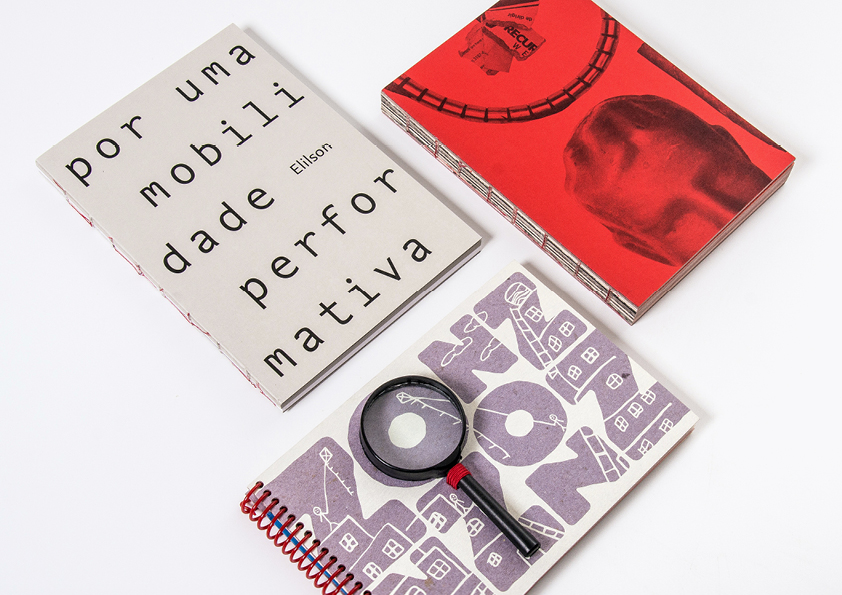




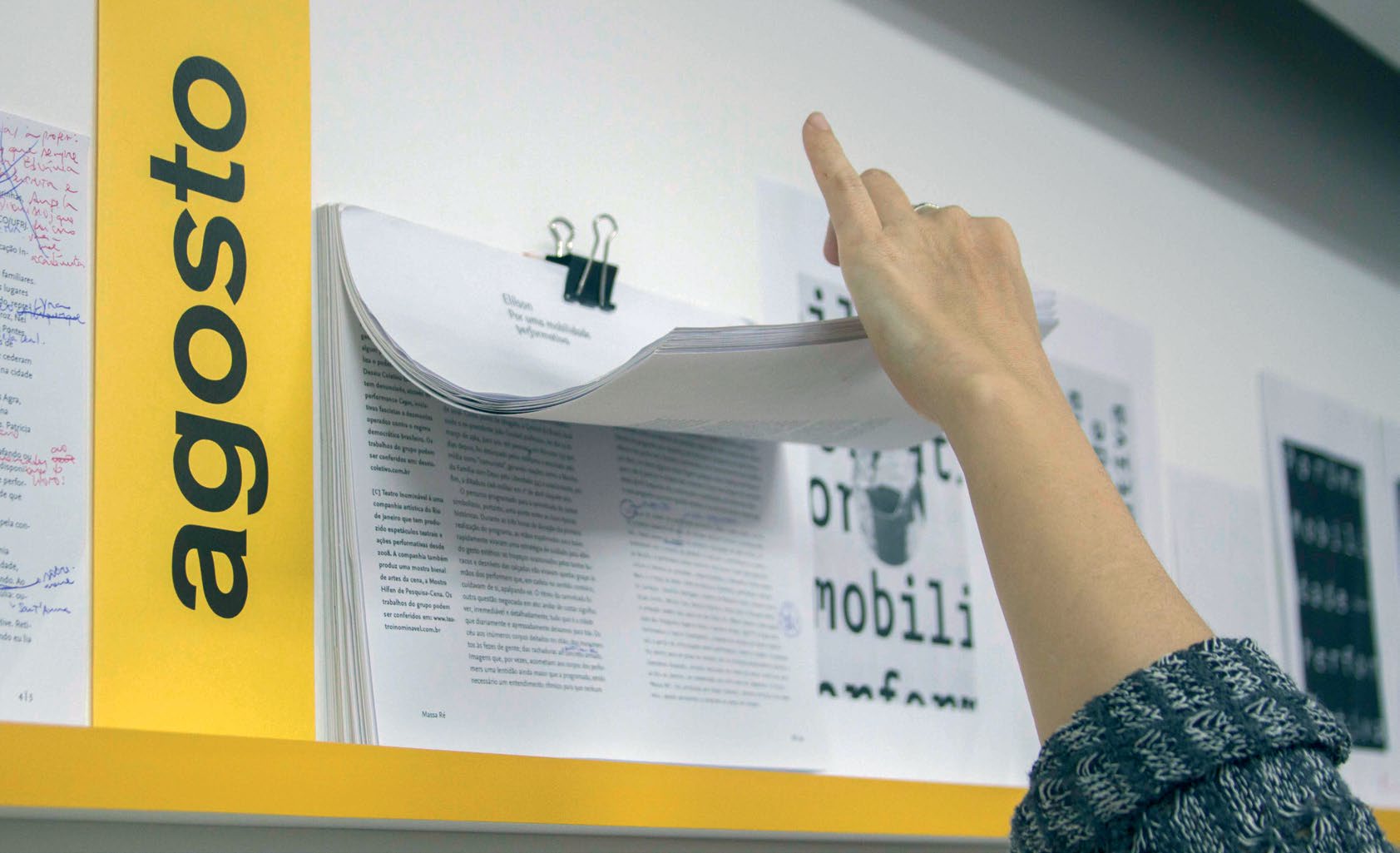

De quem te protege a muralha? / Who Protects You from the Wall? (Thiago Florencio)


Por uma mobilidade performativa / Performative Mobility (Elilson)


Zonzo: investigadores urbanos / Zonzo: urban researchers (Julia Sant’Anna & Carolina Movilla)
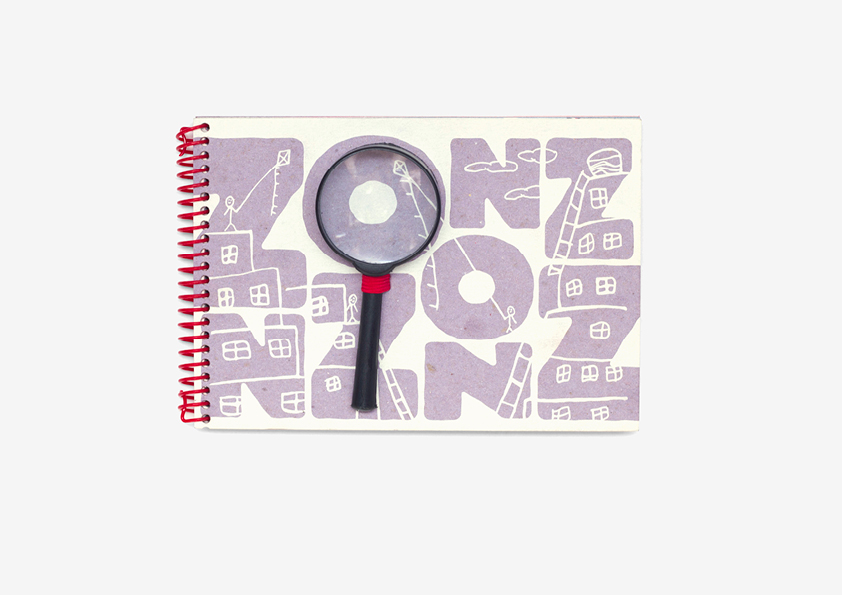
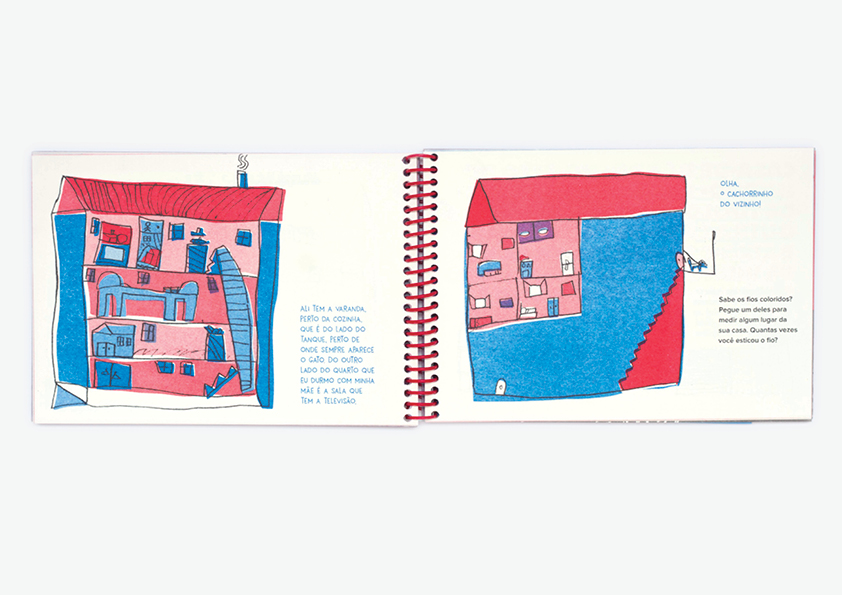

Exposição e publicação desenvolvidas como curadora residente no programa de 3 meses do Node Center for Curatorial Studies, Berlim.
Exposição: Dezembro de 2013
Meinblau e.V. (Christinenstr. 18/19, 10119), Berlim
O objetivo da exposição foi enfatizar o papel do curador como tradutor, explorando como uma mudança de abordagem pode revelar e ampliar as camadas de significação entre as obras de arte. Em seu sentido mais básico, uma tradução é a conversão de algo em uma linguagem para outra. O resultado deve manter a essência do original mas inevitavelmente, ganha uma vida própria.
O processo de traduzir implica múltiplas leituras do mesmo assunto, objeto ou conceito. Essa noção pode ser transferida para o campo da arte: envolve ações de repetição, desconstrução, reconfiguração e sistematização. Cada um desses aspectos aparece dentro das práticas dos cinco artistas dessa exposição: Andrea Canepa (PE), Saskia Noor van Imhoff (NL), Jacob Kirkegaard (DK), Maria Lucrezia Schiavarelli (IT) and Sam Smith (AU). Objetos não artísticos relacionados aos aspectos foram adicionados no espaço para agir como sugestões de abordagens, destacando diferentes aspectos das práticas artísticas presentes.
Exposição: Dezembro de 2013
Meinblau e.V. (Christinenstr. 18/19, 10119), Berlim
O objetivo da exposição foi enfatizar o papel do curador como tradutor, explorando como uma mudança de abordagem pode revelar e ampliar as camadas de significação entre as obras de arte. Em seu sentido mais básico, uma tradução é a conversão de algo em uma linguagem para outra. O resultado deve manter a essência do original mas inevitavelmente, ganha uma vida própria.
O processo de traduzir implica múltiplas leituras do mesmo assunto, objeto ou conceito. Essa noção pode ser transferida para o campo da arte: envolve ações de repetição, desconstrução, reconfiguração e sistematização. Cada um desses aspectos aparece dentro das práticas dos cinco artistas dessa exposição: Andrea Canepa (PE), Saskia Noor van Imhoff (NL), Jacob Kirkegaard (DK), Maria Lucrezia Schiavarelli (IT) and Sam Smith (AU). Objetos não artísticos relacionados aos aspectos foram adicionados no espaço para agir como sugestões de abordagens, destacando diferentes aspectos das práticas artísticas presentes.
Exhibition and publication by Node Resident Curators, Autumn 2013
Node Center for Curatorial Studies, Berlin
Exhibition: December, 2013
At: Meinblau e.V. Christinenstr. 18/19, 10119 Berlin
This exhibition intends to stress the role of the curator as translator by exploring how a shift of approach can uncover and expand the layers within artworks. In its most basic sense, translation is the conversion of something from one language to another. The translated outcome attempts to maintain the essence of the original, yet inevitably takes on a life of its own.
The process of translation implies multiple readings of the same subject, object or concept. This notion is transferable to the art field: it involves actions of repetition, deconstruction, reconfiguration and systematization. Each of these topics recurs within the practice of the five artists in the exhibition: Andrea Canepa (PE), Saskia Noor van Imhoff (NL), Jacob Kirkegaard (DK), Maria Lucrezia Schiavarelli (IT) and Sam Smith (AU). Non-art objects related to each topic will act as positions from which to approach the works, highlighting different aspects within each artist’s practice.
Node Center for Curatorial Studies, Berlin
Exhibition: December, 2013
At: Meinblau e.V. Christinenstr. 18/19, 10119 Berlin
This exhibition intends to stress the role of the curator as translator by exploring how a shift of approach can uncover and expand the layers within artworks. In its most basic sense, translation is the conversion of something from one language to another. The translated outcome attempts to maintain the essence of the original, yet inevitably takes on a life of its own.
The process of translation implies multiple readings of the same subject, object or concept. This notion is transferable to the art field: it involves actions of repetition, deconstruction, reconfiguration and systematization. Each of these topics recurs within the practice of the five artists in the exhibition: Andrea Canepa (PE), Saskia Noor van Imhoff (NL), Jacob Kirkegaard (DK), Maria Lucrezia Schiavarelli (IT) and Sam Smith (AU). Non-art objects related to each topic will act as positions from which to approach the works, highlighting different aspects within each artist’s practice.
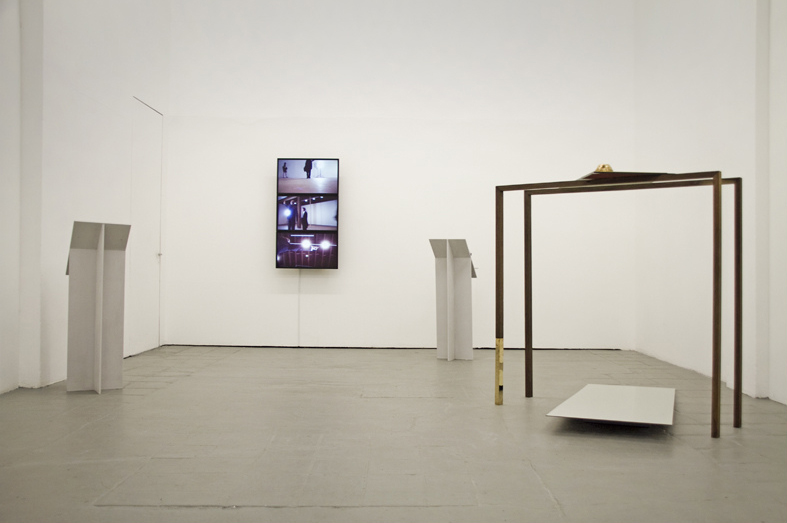
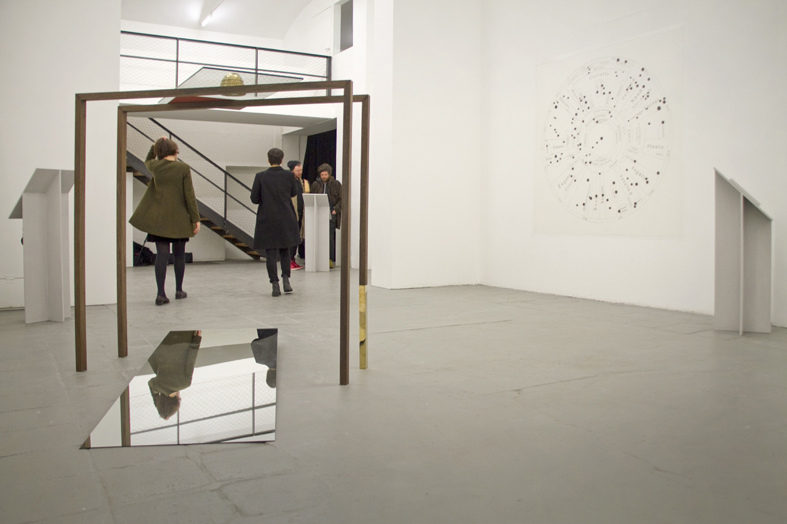
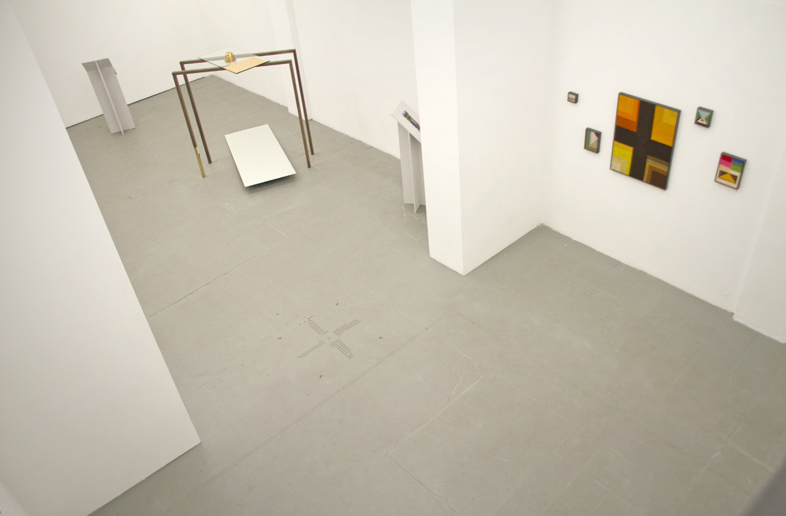



Eu tive a oportunidade e o prazer de participar do SVA Design Writing and Research Summer Intensive. Foi uma experiência incrível para experimentar diferentes métodos de pesquisa e formatos de escrita. A proposta feita por Adam Harrison Levy era criar uma narrativa a partir de uma imagem tirada pelo legendário fotógrafo novaiorquino Weegee. Fui presenteada com a imagem do balão de papai Noel sendo inflado para a parada do dia de ação de graças promovida pela loja de departamento Macy‘s. Eu gostaria de dividir essa história de Natal.
Esse texto foi originalmente escrito em inglês, não foi traduzido para português.
Esse texto foi originalmente escrito em inglês, não foi traduzido para português.
I had the pleasure to be part of the SVA Design Writing and Research Summer Intensive. It was a amazing opportunity to experiment with different research methods and writing formats. Adam Harrison Levy's assignment was to create a narrative story inspired by pictures of the legendary photographer Weegee. The picture that was given to me was the Macy's Thanksgiving Day Parade Santa Claus ballon. I would like to share with you this Christmas Story.
The photographer known for his tight close-ups of arrested criminals, celebrities or everyday new yorkers, usually looks his subjects directly in the eye. Here he trains his camera on a character that can’t look at him. He is laid on the floor and has bulging eyes but he is not dead, actually he is waking up in the early morning. Forty-five foot high, he is the super hero of the holiday season: the floating Santa balloon in the 1940 annual Thanksgiving Day Parade of R. H. Macy’s in Midtown Manhattan.
In the summer of 1940, Weegee was hired by the New York daily newspaper PM. Along with his more typical photos of crime scenes, he also used to take pictures of the city. He was asked to deliver stories about common people, looking for what they used to do during their free time and on holidays. The Thanksgiving Parade balloons were inflated early in the morning and the photographer had a special interest in them, shooting other characters such as clowns and animals. The Santa balloon was a familiar figure at the parade and stood together with the live flesh and blood version of Santa Claus, known for climbing the Macy’s storefront. The gigantic figure was designed in 1939 by the puppeteer and illustrator Tony Sarg and was the biggest balloon at the time. The picture was taken in November 21, 1940. While 12 men, 8000 cubic meters of helium gas, 150 cubic feet of protecting canvas and a vacuum cleaner were combining efforts during two hours to bring Santa Claus to life, Weegee couldn’t know that he was witnessing the Santa balloon’s last appearance.
In the next years the helium-filled reproduction of Santa Claus would not be there again. In 1941 Santa would lead the procession of seven big balloons, but collapsed just before the start of the parade and had to be carted off in a truck. Fifty thousand spectators at the 106th Street were disappointed while Santa deflated in front of their eyes. In the year of 1942 the president of Macy’s, Jack I. Straus, in a patriotic movement, announced that the department store would not hold the parade that year because of war efforts and a shortage of rubber and helium. The waste of gasoline and the required service of 3000 policeman also were considered in this decision. In a ceremony held on the City Hall seven giant balloons were donated to the government’s rubber scrap adding 650 pounds to the pile to be converted to rubber for tanks and planes. Superman, a reluctant dragon, a clown, a goldfish, a pink dumbo, a football player (which some people suspected was the superman of 1940 repainted) and Santa Claus were sacrificed. As a farewell, the dragon was inflated with air for the last time in order to be punched by a new specimen of Saint George: the Mayor of New York La Guardia. In the next 2 years, Macy’s kept the decision to eliminate the parade.
1945 brought a reason to celebrate. Hope was back into the air and so were the balloons. With the end of the war, Goodyear was again able to produce for the department store the giant flying characters. Not anymore with the unique design made famous by Tony Sarg, as he died in 1942. A new era was coming. The balloons were enlisted to the war but they managed to return to the enlightenment of the city, for the joy of Macy’s marketing team and the good of the sales.
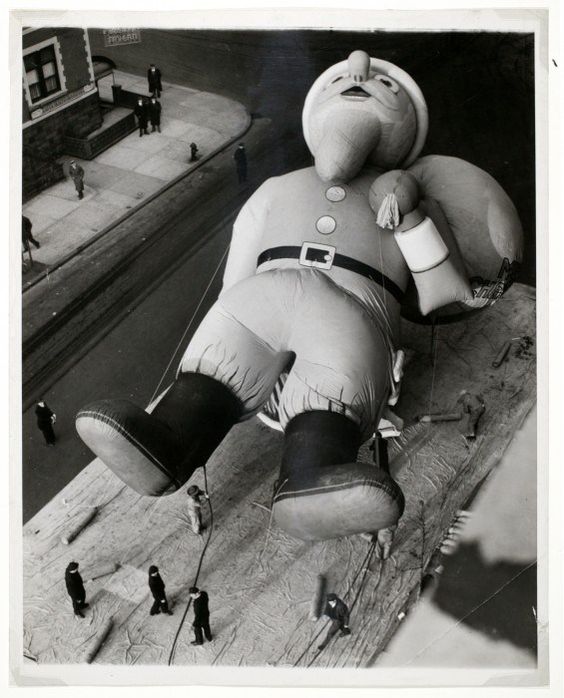
Platform Project
2014
Publicação colaborativa dos 22 participantes do curso de verão do SVA Design and Research. Coordenada por Mimi Zeiger e design de Neil Donnelly.
Em duas semanas os participantes visitaram 4 espaços da cidade de Nova York: MoMA/ Folk Art Museum, Penn Station/Madison Square Garden, Domino Sugar Factory no Brooklyn e o New York State Pavilion no Queens. Operando em diversas escalas, esses locais fomentam debates públicos sobre seus usos. Em cada um dos lugares, os grupos de alunos descobriram suas auras, investigando seus contextos e seus significados culturais. Algumas questões surgiram: o que faz um lugar? O que move nossa obscessão por preservação? Quando ela se torna abuso? Como nosso futuro parecia olhando do passado?
Os participantes colocaram essas questões via Twitter entre 2 e 13 de junho de 2014, abrindo espaço para conversa. A publicação capture o rastro desse diálogo.
2014
Publicação colaborativa dos 22 participantes do curso de verão do SVA Design and Research. Coordenada por Mimi Zeiger e design de Neil Donnelly.
Em duas semanas os participantes visitaram 4 espaços da cidade de Nova York: MoMA/ Folk Art Museum, Penn Station/Madison Square Garden, Domino Sugar Factory no Brooklyn e o New York State Pavilion no Queens. Operando em diversas escalas, esses locais fomentam debates públicos sobre seus usos. Em cada um dos lugares, os grupos de alunos descobriram suas auras, investigando seus contextos e seus significados culturais. Algumas questões surgiram: o que faz um lugar? O que move nossa obscessão por preservação? Quando ela se torna abuso? Como nosso futuro parecia olhando do passado?
Os participantes colocaram essas questões via Twitter entre 2 e 13 de junho de 2014, abrindo espaço para conversa. A publicação capture o rastro desse diálogo.
Platform Project
2014
Collaborative publication authored by twenty-one Summer Residency participants, with Mimi Zeiger and design by Neil Donnelly.
Over the course of two weeks, program participants visited four sites in New York City: MoMA/ Folk Art Museum, Penn Station/Madison Square Garden, Domino Sugar Factory in Brooklyn, and the New York State Pavilion in Queens. Operating across several scales, these sites spark public debate. At each location, teams sought out the aura of the place, investigating and researching cultural and contextual significances. Questions arose: What makes a place? What fuels our obsession with preservation? When does use become abuse? What did our future look like from the past?
Project participants engaged these questions via Twitter from June 2–13, 2014, opening up a space for conversation. This publication captures a trace of their dialogue.
2014
Collaborative publication authored by twenty-one Summer Residency participants, with Mimi Zeiger and design by Neil Donnelly.
Over the course of two weeks, program participants visited four sites in New York City: MoMA/ Folk Art Museum, Penn Station/Madison Square Garden, Domino Sugar Factory in Brooklyn, and the New York State Pavilion in Queens. Operating across several scales, these sites spark public debate. At each location, teams sought out the aura of the place, investigating and researching cultural and contextual significances. Questions arose: What makes a place? What fuels our obsession with preservation? When does use become abuse? What did our future look like from the past?
Project participants engaged these questions via Twitter from June 2–13, 2014, opening up a space for conversation. This publication captures a trace of their dialogue.
